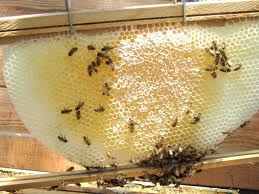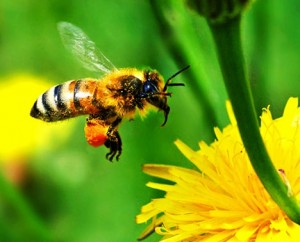 Honey bees use wax to build comb that forms their nest and the intricate hexagonal cells that make up that comb. These wax cells are used to house the various stages of bee young (or brood) as they develop from egg to adulthood. In addition wax cells are used to store pollen and nectar.
Honey bees use wax to build comb that forms their nest and the intricate hexagonal cells that make up that comb. These wax cells are used to house the various stages of bee young (or brood) as they develop from egg to adulthood. In addition wax cells are used to store pollen and nectar.
Wax is produced as needed by worker bees to form and repair comb and individual cells. The wax is secreted by these worker bees, from eight special wax glands situated on the underside of their abdomens (inside the protective plates or sternites of abdominal segments 4 to 7). Worker bees produce wax most efficiently during the 10th through to the 16th days of their lives and this declines steadily from day 18 until the end of life.
When wax is required these workers fill themselves up with honey and then hang together in clusters to contain the heat generated by the metabolism of the honey in their muscles. This resultant rise in temperature allows the wax to be secreted from the bee’s wax glands and this secreted wax then pours into special holders beneath these glands and solidifies.
The eight translucent white blobs of wax that are formed are then removed by the bee using her end pair of legs and either passed to her mouth or to the mouth of others to carry to another part of the comb. The wax is worked on and manipulated until the consistency is right and it is then moulded into position using the bees mandibles (or mouth parts) and the comb is built up to the size required to house newly laid eggs or food stores. It is in the mastication process that salivary secretions are added to the wax to help soften it and this also accounts for its change of colour. The colour of beeswax in a comb is white at first and then darkens with age and use, especially if it is used to raise brood.
It is believed that 6-8 pounds of honey is needed to produce a pound of bees wax and it is estimated that bees fly 150,000 miles, roughly six times around the earth, to yield one pound of beeswax (530,000 km/kg).
More about Honey Bee Physiology and Anatomy

